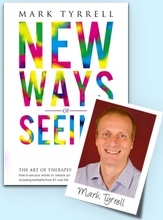
Anger is a powerful survival tool, but when it goes unchecked it can be a destructive force
“You will not be punished for your anger, you will be punished by your anger.”
–Buddha
The veins lacing across Graham’s temples looked ready to burst.
Graham, an eminent mathematics professor, had been told he had “anger management issues”.
“…but most people just think I’m just a “wan**r!”
There was challenge in his eyes as he said, “And anyway, what good is just being told that? I want to know how to control it!”
Prefer to watch instead?
Graham was almost a caricature of an angry man. Tense neck and jaw, arched eyebrows. I suddenly saw how much there is to pity in the chronically angry – trapped as they are in an invisible prison.
And now, as Graham became enraged about his rage, I began to see just how hard it was for him – as well as for all the eggshell-treading folk who populated his life.
A university professor with a stratospheric IQ, this piercingly bright man had done some amazingly dumb things while angry.
“I’m now off work with stress,” he told me.
“Why?”
“I threw a chair through a window at work because a student was driving me nuts. He just kept arguing over everything I was saying… I was such an idiot!” There was a hint of tears in his eyes now.
Anger had stolen a lot from Graham. Many friendships, two wives (consecutively), his job and even his health – he’d been having heart problems.
I was struck by the thought that his was a classic case. Graham was suffering many of the side effects of anger.
I’m talking about destructive anger here. Yes, I know that sometimes anger can be a magnificent tool with which to fuel courageous change, challenge injustice and sweep inertia aside. But not for the chronically angry, who are weighed down and sometimes destroyed by this most powerful of natural survival tools.
More is understood about the effects of anger than ever before. And therapists need to be on top of all there is to know about this emotion too.
How anger affects the brain (angry = stupid)
We are children of the ‘let it all hang out’ generation, where emotional outbursts are seen as natural; cathartic. At first, questioning or criticizing this paradigm of the passions can seem uncomfortable, even absurd. But when we do delve into the way we experience them, we find that unregulated emotions are the root of much misery.
Anger can be addictive. Unlike anxiety, shame or depression, anger drives us towards the object of our arousal.
Curiously, during anger the left hemisphere is strongly activated, meaning that a kind of simplistic logic is used – but the context-processing right hemisphere is all but dumped in the moment. It seems logical to lash out, if any thought is involved at all. But the wider context (this is your best friend’s wedding!) may not be appreciated.
Like any addiction, chronic anger seems to promise real rewards, but ultimately takes more than it gives. Some get a buzz from the excitement it provides in an otherwise dull day. Testosterone increases, as does energizing adrenaline. Some get hooked on the intensity even though for many it feels deeply unpleasant – even scary – to feel angry.
In chronic anger, we may find a fast-tracked means of receiving attention from others: a kind of status, as people constantly monitor us to see how we’ll take things. “Is he/she going to be okay with this?” And, delightfully, in moments of rage we lose our self-consciousness.
Go ahead, just try being shy whilst swept along in the heady paroxysms of outrage. The two can’t co-exist. There is a certain joy in self-righteous certainty when so much of life seems ambiguous. But of course, there is a price to pay…
Extreme anger makes us stupid. It makes us do stuff we may come to bitterly regret. What seems like a good idea when we are angry can seem really stupid when we calm down. The angrier we become, the more our ability to process subtlety and nuance suffers.
When strong negative emotions hijack the thinking brain, IQ drops like a stone. Even the brightest mathematics professor can, when enraged, appear scarcely more coherent than an incensed gorilla.
Reality comes to be seen in simplistic, good-or-bad, all-or-nothing perspectives, as sensational as tabloid news headlines. Other people come to be seen as ‘stupid’ or ‘evil’ for having differing opinions. All kinds of neutral events are seen, paranoically, as intentional threats.
So many people have lost their lives to anger. But not just by being the victim of someone else’s anger.
Anger kills – but not just the other guy
Psychotherapists used to think that it was ‘healthy’ to express anger; to ‘let it all out’. Emotions were supposed to work in the same way as hydraulic technology. People were like pressure cookers that needed to ‘let off steam’. These technology metaphors are still in use. But there’s a problem with this model.
Trouble is, Graham was great at venting, great at ‘letting it all hang out’ – but anger was still damaging his life and affecting his health.
Don’t get me wrong: some venting can be healthy, especially when it leads to increased assertiveness. But modern research has found that extreme anger is just as damaging to the heart(1) and to immune function(2) if it is released as if it’s kept in(3).
Contrary to popular psychotherapeutic thought from the 1970s, constantly letting anger out doesn’t get rid of it. In fact, being angrier may simply make us better at getting angrier(4). The more you do something, the more likely you are to do it.
So venting anger isn’t automatically superior to keeping it in, as far as your health is concerned. The surprising truth is that getting very angry very often is a strong predictor of early death through heart disease. In fact, even recalling times you felt very angry can be bad for the heart.
And of course, millions have been traumatized or even killed because other people chose to express rather than suppress their anger.
We practitioners should not be encouraging our clients to get angry all the time(5). Teaching people to control themselves can save their own lives, as well as the lives of the targets of their rage.
Good anger management isn’t about ‘learning to express your anger’ (expressing something about which you are unhappy is best done assertively and calmly rather than angrily). Nor is it about bottling it all up, which still compromises blood pressure and heart function. It is about becoming less angry, less often.
Certainly we can look at how and perhaps why the anger germinated. Was this person brought up in an environment that conditioned them to feel that everything was a fight? Were they spoiled by over-indulgent parents who made them feel like they were the centre of everything and that their needs must take precedence over everyone else’s? Do they have a brain injury that causes uncontrolled bouts of rage?
Exploring emotional etiology may be of use, particularly if we can reframe their experience of the past. But ultimately we want our angry clients to live better now and in the future. Unless we need to detraumatize past events in order to create this change, we shouldn’t just focus on emotional archaeology.
So, how can we help our clients take back the reins of their minds?
1. Discover what pushes your clients’ buttons
Graham became enraged when he was exhausted and overworked. In the lead-up to the chair-throwing incident, he had not been sleeping and had also been drinking too much. He also told me whenever he felt he was not being listened to he would sense the red mist descending. There were other triggers too.
Becoming angry can work just like a hypnotic trigger – becoming automatic before ‘we’, in our cognitive mind, even know it.
Anger is also very conditioning. What I mean by that is, if, for example, you have been angry with a certain person a few times, you can become conditioned to feel anger towards them automatically. Just hearing their name may even produce a shot of irritation.
Get to know your clients’ triggers, and get them to know them too so that you can rehearse switching off those triggers when they pop up.
2. Insert some distance between clients and the source of frustration
When we are hijacked by emotion, thinking is substituted for feeling. In fact, sometimes there is no real thinking at all.
In the British House of Commons, where politicians bicker – sorry, ‘debate’ – the distance between the government ministers and those of the opposition is traditionally ‘two swords and one inch’. Why?
Because in days of yore when swords were worn, it was thought that this extra distance would help people engage the thinking brain before acting on emotion. They would have time to question whether running the other fellow through really was such a great idea (given that there was hanging and all, back then!)
We can teach our clients to give themselves space and time during potentially enraging situations to get back in touch with their thinking brain.
I taught Graham how to breathe so that he could calm down fast, count to ten and tell himself “I am becoming calmer” between one count and the next.
He was also to remind himself that even – especially! – if the other person was wrong or ‘out of order’, he didn’t need to waste energy and damage his heart further on them. He later reported that just having this strategy was really useful in depotentiating anger.
But we can help our clients more powerfully still.
3. Use rehearsal to help your client see wider
Anger narrows focus, a destructive emotional trance. When I am enraged, I see reality only as all-or-nothing and miss the shades of grey. The more black-and-white our view, the angrier we become.
But, in a vicious cycle, anger makes our thinking more black-and-white. Think of the language that angry people use (other than the cursing). It tends to be all-or-nothing: “I’m completely right and you’re completely wrong!” Anger makes us see ill intent in others when in fact they may have simply made an honest mistake: “You did that on purpose!”
But we can help our clients remove themselves emotionally from the situation, letting them see wider and further. How?
There is a beautiful hypnotic exercise I did with Graham. Like most angry people, Graham was very good at being hypnotized (because he was so good at narrowing his focus!).
I asked him to think about the last time he got really angry and right on cue he started getting worked up. So after a few seconds, not wanting to damage the poor guy, I asked him to refocus externally and take some breaths.
Then I asked him to close his eyes again and watch that time from the outside, as if he were a third person observer. This time he felt calm and slightly embarrassed and noticed things about the interaction that he’d never seen before, such as how he was closing in on the other person’s personal space and not listening.
I then got him to open his eyes and close them again and observe the interaction with a resolution it could have had, if he’d remained calm. This was amazing to him.
We then had him rehearse watching over and over potential instances from the future in which, before undergoing any treatment, he typically would have become angry – but this time with him remaining calm and in control. I am convinced this really helped Graham.
If you don’t have hypnotic skills or do inner work with your clients, you could simply ask them to ask themselves during those times: “What is another way of looking at this?” Develop their self-doubt as a tool: “In what way may I have missed something?”
I’m reminded of a friend who once spoke angrily to a neighbour who never seemed to reply to her attempts at polite conversation. Her anger evaporated when she discovered… he was stone deaf.
Because anger happens so fast (and makes us forget all these tips), it’s a good idea to help our clients rehearse replacing anger with calm ahead of time so that the response to their triggers is no longer anger.
Have your clients breathe deeply (remember, it’s the extended out-breath that triggers calm) while imagining seeing themselves dealing calmly with life’s frustrations.
4. Don’t get angry, for pity’s sake
Anger makes us see other people as objects to be acted upon rather than human beings to be interacted with. We become angry with someone when we feel they are preventing us from getting what we want.
In that state, other people become mere obstacles to us. And, because we objectify other people when we become enraged, we are more likely to be violent because, after all, objects can be removed or punched (or run down in a car!).
We can help build our clients’ in-the-moment empathy by teaching them to visualize the people who make them angry as human beings with needs, fears, and problems, as well as remembering that at one time they were tiny babies.
Angry people need to see the objects of their ire as… people. But we also need to consider why our clients might be angry.
5. Help them deal with real frustrations
It’s important to ask and find out how (and to what extent) each angry client’s primal needs are met. Just as the experience of thirst is a signal that our need for hydration hasn’t been met, fear, depression and, for some, anger, can all be signals that other needs remain unfulfilled.
Take a good look at your client’s life. We all have needs: needs for sufficient sleep, food, attention, meaning, status, stimulation, and so on. How well are these needs met in your client’s life? Is your client skipping nutritious meals but binging on sugar? Graham was. Are they getting enough good quality sleep? Graham wasn’t. Are they satisfied in their work and in their social life?
Not getting needs met isn’t an excuse for getting angry, but it does make it more likely. One of the first things I’ll ask a client is: “How is your sleep?” Sometimes when we sort out sleep, we sort out the anger problem as well.
Graham found that as he became less angry he started to sleep better, stopped drinking so much and found it easier to socialize again. Meeting these needs better, in turn, meant he was less likely to get angry.
Inhabiting heaven
In our last session Graham told me it felt like “heaven” to be able to “chill” when he used to “overheat”. I thought it funny he used the word “heaven” because, in our very first session, as he was resting in trance, I’d told him this story:
Once, in ancient Japan, there was a young samurai warrior. His mastery of the sword was strong; his mastery of self – weak. He happened, one morning, to come into the presence of a wise old man who was reputedly an even better swordsman than the young upstart but who didn’t feel the need to impress others.
“If you are so wise,” demanded the younger man, “then explain to me the meaning of Hell and Heaven!”
The old man turned on the young samurai. “Why should I even speak to one as bloated on self-importance, so mired in self-opinion, so stuffed full of conceit as you? Be gone, weak man!”
No one had ever dared speak to the young samurai like that before! Infuriated beyond measure, hands shaking with rage, he drew his sword and went as if to separate the ancient sage’s head from his body.
But at this point the older one turned calmly and said: “In answer to your question: that, my child, is Hell!”
The warrior was amazed and humbled that the other man should endanger his own life to illustrate a point, and quickly regained control over himself again. And seeing the hot-headed youth calm down, the old man gently pointed out:
“And this, my son, is Heaven!”
And you can free your clients from the prison of their negative feelings with our Conversational Reframing course, which teaches you to unlock strongly-held beliefs. Read more about the course here and sign up to be notified when it’s open for booking.
Notes:
(1) http://linkinghub.elsevier.com/retrieve/pii/S0735109708041259?via=sd
(2) https://www.ncbi.nlm.nih.gov/pubmed/20045413
(3) Ironson, G (1992), Effects of anger on left ventricular ejection fraction in coronary heart disease, American Journal of Cardiology, 70
(4) Repeatedly expressing anger can have the effect of strengthening the anger pathways in the brain, making us more likely to become angry more often, according to Donald Hebb, the psychologist who proposed ‘Hebbian learning’.
(5) In one study, conducted at Stanford Medical School, heart patients were asked to recall times when they had been angry. Although, according to the patients, the anger they felt on recalling the events was only half as strong as it had been during the original experience, their hearts started pumping, on average, 5% less efficiently. Cardiologists view a 7% drop in pumping efficiency as serious enough to cause a heart attack.







